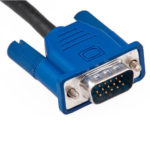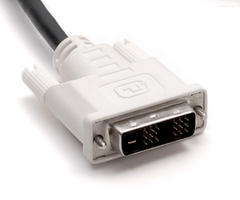Connectors Series: What is D-Sub?
If you’ve been following our blog, you know we’ve been covering different types of electrical connectors. This month we dive into D-Sub connectors, also known as D-subminiature or simply DB. While they’re mostly obsolete, these tough connectors are still in use today. Learn what makes these connectors stand out and how they’ve led us to new technologies.
What is D Sub? (AKA D-Subminiature or DB connectors)
It’s hard to imagine, but D-Sub connectors were the smallest type of connector used in computer systems. They connected computers to monitors, printers, and floppy disc drives. While they’re no longer prevalent in consumer electronics, they’re still used in some commercial equipment.
Their strongest feature is the two screws that hold the connector in place making a semi-permanent connection. Their D-shaped metal shield also provides mechanical support, ensures correct orientation, and can possibly screen against electromagnetic interference. Another advantage to the vintage electrical connector, is the numerous pins and sockets it can carry. Choose between low density D-subs with two rows of pins/sockets or high-density D-subs with three rows.
One of the few places D-Subs still exist is in RS-232 serial communications. Network ports, computer video output, and game controller ports now feature smaller, more efficient connectors such as HDMI and DisplayPort. Yet, D-Subs have survived these technological advances due to their robust build.
D-Sub vs. VGA v. DVI

The downside to D-Subs is not only their bulkiness, but their signal transmission is also rather poor. VGA, or Video Graphics Array, is a specific type of D-Sub connector; DE-15. While most D-Sub connectors are completely obsolete, DE-15 remains only slightly obsolete. They carry analog video signals for use on older computer models and monitors. The name DE-15 refers to an “E” size D-Sub connector with 15 pins in three rows.

The first innovation to display interfaces came with the DVI connector in 1999. DVI, or Digital Visual Interface, can support both analog and digital signals. This connector comes in three variations: DVI-A (analog only), DVI-D (digital only), and DVI-I (analog and digital). The introduction of digital signals created a cleaner, faster, and more precise video display. DVI connectors are also hot-pluggable which means users can quickly connect and disconnect the cable without worrying about potential damage. As you may have guessed, the analog-only DVI connector has been phased out along with VGA.

HDMI, DisplayPort, and Beyond
The issue with VGA and DVI connectors is they can only transmit video signals. HDMI and DisplayPort connectors solve that. Introduced in 2002, HDMI (High Definition Media Output) combines video and audio signals in a single, compact, pluggable connector. It’s used with computer monitors, digital TVs, and DVD or Blu-ray players. The latest update to HDMI can support 24-bit uncompressed audio at 192 kHz and video resolutions up to 4096 x 2160, also known as 4K or Ultra HD.

DisplayPort is another digital display interface introduced in 2008 that can carry both video and audio signals. It’s mainly used to connect computing devices to monitors since DisplayPort operates with packet data transmission commonly found in Ethernet and USB connections. The latest version of DisplayPort boasts support for resolutions up to 8K (7680 x 4320) at 60 Hz.
USB Type C over HDMI (HDMI Alt Mode)
If you can’t decide which connector to use, don’t worry. Just like with USB connectors, HDMI connectors are in the process of standardization. In our USB connectors blog we covered the new USB Type C that when paired with USB 3.1 technology is an all-in-one connector that can transmit data, power, and video signals. A new USB type C over HDMI cable is in the works which would eliminate the need for USB to HDMI adaptors. Connecting electronic devices to displays would require only a single cable.
The great thing about cables and connectors is they can be customized for almost any situation. Luckily our Electromechanical Manufacturing Group has experience working with a variety of electrical connectors. Does your project require a custom cable with a VGA connector? We’ve got you covered.
D-Sub connectors may be outdated, but they’ve inspired a series of progressively better display interfaces. Every now and then you’ll come across a rare VGA or DVI-A connector in its native habitat, usually in antique shops. Learn more about USB Type-C in our USB connectors blog. Plus, stay tuned for the final installment in our Connectors Series where we cover power connectors.

